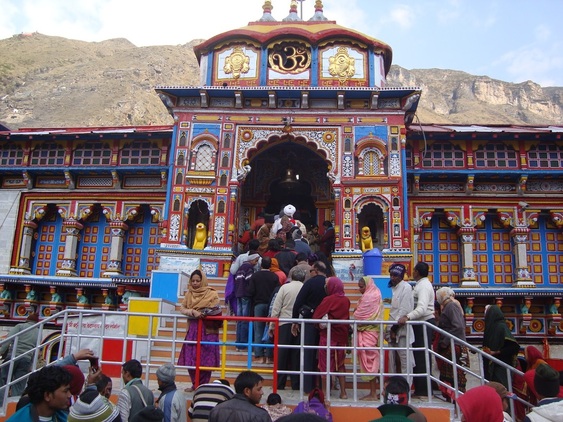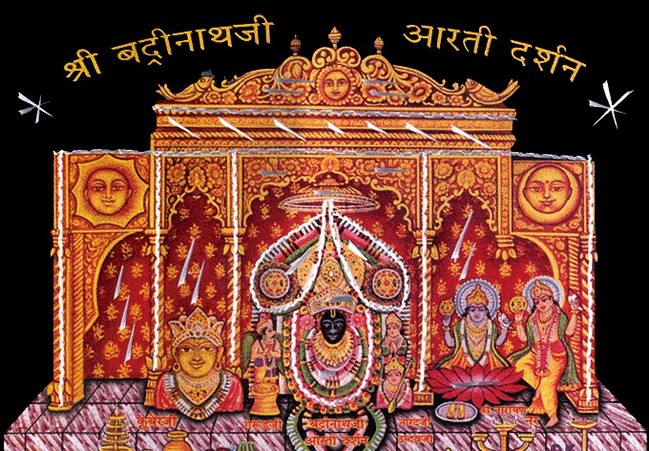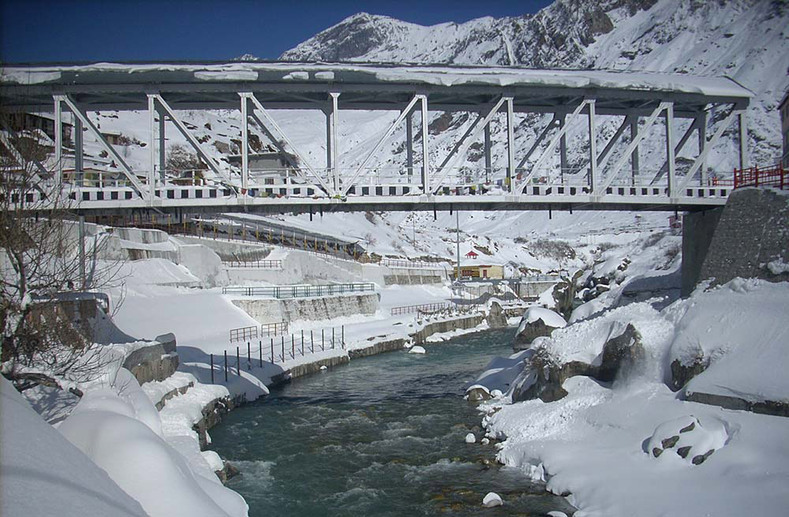SHRI BADARINATH TEMPLE
Uttarakhand
Name of the Temple : Shri Badarinath
Main Deity : Maha Vishnu
Local Name : Badri Narayan, Badri Vishal
Location : Badrinath Town, Chamoli District, Uttarakhand
Nearest City : Rishikesh
Website : http://badarikedar.org/
Importance of the temple: This is most important of the char dhams (Puri, Badrinath, Dwaraka and Rameshwaram) and is also one of the 108 divya desams, holy shrine of Vaishnavites. In the puranas, badrinath has been referred as Bhulok Vaikunth. Brahma kapal is a place in Badrinath which is of great importance for Hindus as they pay homage to the dead souls of their ancestors here. If someone does Rituals and Shraddha Karm for the departed souls of his family, they get salvation (moksha) and get rid from the cycle of re-birth and death.
History:
Badrinath is located on the banks of River Alaknanda dedicated to Lord Vishnu. The hill tracks are located 3,133 m (10,279 ft) above the main sea level. Alaknanda River adds the beauty to this place. The image of Badarinarayan here is a Saligramam. Lord Badri Narayan is armed with Conch (sankh) and Chakra in two arms and two arms rested in Yogic Pose. Bhagwan Sri Badri Narayan is seen under a Badari tree. It is believed that Lord MahaVishnu have done his penance here. Seeing the Lord doing his penance in the open, Goddess Mahalaxmi is believed to have assumed the form of Badari tree to provide him shelter to face the onslaught of the adverse weather conditions, therefore the name Badari Narayan. Lord here is flanked by Kuber and Garuda, Narad, Narayan and Nar. On the left side of Badri Narayan is Uddhava. To the far left side are Nar and Narayan. Narad Muni is kneeling in front on the left side. On the right side is Kubera. Garuda is kneeling in front of Badri Narayana.
Name of the Temple : Shri Badarinath
Main Deity : Maha Vishnu
Local Name : Badri Narayan, Badri Vishal
Location : Badrinath Town, Chamoli District, Uttarakhand
Nearest City : Rishikesh
Website : http://badarikedar.org/
Importance of the temple: This is most important of the char dhams (Puri, Badrinath, Dwaraka and Rameshwaram) and is also one of the 108 divya desams, holy shrine of Vaishnavites. In the puranas, badrinath has been referred as Bhulok Vaikunth. Brahma kapal is a place in Badrinath which is of great importance for Hindus as they pay homage to the dead souls of their ancestors here. If someone does Rituals and Shraddha Karm for the departed souls of his family, they get salvation (moksha) and get rid from the cycle of re-birth and death.
History:
Badrinath is located on the banks of River Alaknanda dedicated to Lord Vishnu. The hill tracks are located 3,133 m (10,279 ft) above the main sea level. Alaknanda River adds the beauty to this place. The image of Badarinarayan here is a Saligramam. Lord Badri Narayan is armed with Conch (sankh) and Chakra in two arms and two arms rested in Yogic Pose. Bhagwan Sri Badri Narayan is seen under a Badari tree. It is believed that Lord MahaVishnu have done his penance here. Seeing the Lord doing his penance in the open, Goddess Mahalaxmi is believed to have assumed the form of Badari tree to provide him shelter to face the onslaught of the adverse weather conditions, therefore the name Badari Narayan. Lord here is flanked by Kuber and Garuda, Narad, Narayan and Nar. On the left side of Badri Narayan is Uddhava. To the far left side are Nar and Narayan. Narad Muni is kneeling in front on the left side. On the right side is Kubera. Garuda is kneeling in front of Badri Narayana.
Though this shrine is located in the northern part of India, the Chief Priest Ravalji -of Keralite (Namboodri) origins - performs the rituals. Whenever Sri Rawal ji has to go for Puja, Abhishek or Bhog for Bhagwan badri he has to take a bath each time and has to take care that no one should touch him. He is taken with great respect to the temple and in his respect one person always remain with him holding a golden stick. Procedures of daily pujas and rituals are supposed to have been prescribed by Adi Sankara. Unlike most of the Hindu temples all the pujas (including decoration of idols) are performed in the presence of the devotees.
The Place where Badri Narayan resides is called Bhulok Vaikunth. Yoga maya of Sriman Narayan is supposed to be spread across the mountains. So, all the mountains are also worshipable. All our sins are washed away once we have darshan of Badri Narayan. Evening there will be arati for River Alaknanda.
Places of interest:
1. Nar and Narayan mountains - These are the mountains where Nar and Narayan performed Tapasya. Nar and Narayan are Arjuna and Krishna in dwapar yug.
2. Tapt Kund - Tapt Kund is a hot water spring. It is said that the water here emerges from the feet of Shri Badri Narayan. Tapt Kund is located between panch shilas. Any dan (donation) performed here gives one akshaya (unlimited) punya.
a. Narad Shila - We have narad shila here. Located between Narad Kund and Tapt Kund is a block of stone called Narad Shila where sage Narad is said to have meditated for several years. After taking bath in Tapt Kund, devotees proceed to have darshan of Alaknanda river.
The Place where Badri Narayan resides is called Bhulok Vaikunth. Yoga maya of Sriman Narayan is supposed to be spread across the mountains. So, all the mountains are also worshipable. All our sins are washed away once we have darshan of Badri Narayan. Evening there will be arati for River Alaknanda.
Places of interest:
1. Nar and Narayan mountains - These are the mountains where Nar and Narayan performed Tapasya. Nar and Narayan are Arjuna and Krishna in dwapar yug.
2. Tapt Kund - Tapt Kund is a hot water spring. It is said that the water here emerges from the feet of Shri Badri Narayan. Tapt Kund is located between panch shilas. Any dan (donation) performed here gives one akshaya (unlimited) punya.
a. Narad Shila - We have narad shila here. Located between Narad Kund and Tapt Kund is a block of stone called Narad Shila where sage Narad is said to have meditated for several years. After taking bath in Tapt Kund, devotees proceed to have darshan of Alaknanda river.
b. Narsimha Shila - Close to Narad Shila, standing in the waters of Alaknanda is a huge stone resembling a lion with its gaping jaws and hooked claws. It’s said that Lord Narsimha after killing the demon king Hiranayakashyap remained here in the form of a stone forever.
c. Varahi Shila - A boar shaped rock believed to be an incarnation of Lord Vishnu.
d. Garud Shila - Garud, the carrier of Lord Vishnu, is said to have fasted and meditated here. Sandalwood paste is prepared for Badri Narayan here. There is also Kedar Shila. Having darshan of Kedar here is important before proceeding to have darshan of Badri Narayan.
e. Markandeya Shila - On the advice of Sage Narad, Sage Markandeya is said to have settled here in Brindavan and meditated on this stone.
3. Brahma Kapal - Once lord Shiva has cut Brahma's fifth head and he got brahma hatya dosh and brahma’s head stick to his hand. Lord Shiva went to many places to get rid of the head from his hand. Finally he came to brahma kund, as soon as he put his hand in the water it got detached from his hand and he was also relieved from brahma hatya dosh. Hence pind dan performed here will provide liberation to seven generations of ancestors.
4. Saraswathi river - It is believed that whoever takes bath here, all their future generations will be blessed with knowledge.
5. Bhima Sila - There is huge stone bridge as the saraswati river water is ferociously flowing beneath it. It is believed that Bhimasena lifted huge stone with one hand and placed it on the river with a view to facilitate the journey of Draupadi along with the Pandavas to Heaven through the Himalayas.
c. Varahi Shila - A boar shaped rock believed to be an incarnation of Lord Vishnu.
d. Garud Shila - Garud, the carrier of Lord Vishnu, is said to have fasted and meditated here. Sandalwood paste is prepared for Badri Narayan here. There is also Kedar Shila. Having darshan of Kedar here is important before proceeding to have darshan of Badri Narayan.
e. Markandeya Shila - On the advice of Sage Narad, Sage Markandeya is said to have settled here in Brindavan and meditated on this stone.
3. Brahma Kapal - Once lord Shiva has cut Brahma's fifth head and he got brahma hatya dosh and brahma’s head stick to his hand. Lord Shiva went to many places to get rid of the head from his hand. Finally he came to brahma kund, as soon as he put his hand in the water it got detached from his hand and he was also relieved from brahma hatya dosh. Hence pind dan performed here will provide liberation to seven generations of ancestors.
4. Saraswathi river - It is believed that whoever takes bath here, all their future generations will be blessed with knowledge.
5. Bhima Sila - There is huge stone bridge as the saraswati river water is ferociously flowing beneath it. It is believed that Bhimasena lifted huge stone with one hand and placed it on the river with a view to facilitate the journey of Draupadi along with the Pandavas to Heaven through the Himalayas.
6. Neelakanta Parvatha – It is the snow clad peaks of the Neelakanta Parvatha which glows like a golden crown of the Himalayan king. It is an enchanting view to see the Bramha Kamal Pushpa grown here which stays fresh for a year.
7. Vyas Guha - (Shamyaprasa - Ashram of Vedavyasa) It is indeed very thrilling and exciting to see the single rocky hillock above the guha of Vedavyasa which appears as though the Thadavali leaves of the voluminous granthas of Vedavyasa have been piled one above the other and have taken the shape of these layered rocks.
8. Ganesh guha - This is the place where Lord Ganesh wrote with tremendous speed and elegance, all the puranas and shastrik granthas which Lord Vedavyasa dictated to him.
How to Reach:
Best way to reach Badrinath is by bus service i.e. via road. Nearest railway station to this town is located in Rishikesh and from there one can take bus to reach Badrinath. Nearest airport is located in Dehradun (Jolly Grant Airport). Best time to visit Badrinath is between May and September.
Air - Nearest airport is Jolly grant, Dehradun (Appr. 315 KM)
Rail - Nearest railhead is Rishikesh (Appr.292 KM)
Road - From Haridwar (310 KM) & From Delhi (510 KM)
7. Vyas Guha - (Shamyaprasa - Ashram of Vedavyasa) It is indeed very thrilling and exciting to see the single rocky hillock above the guha of Vedavyasa which appears as though the Thadavali leaves of the voluminous granthas of Vedavyasa have been piled one above the other and have taken the shape of these layered rocks.
8. Ganesh guha - This is the place where Lord Ganesh wrote with tremendous speed and elegance, all the puranas and shastrik granthas which Lord Vedavyasa dictated to him.
How to Reach:
Best way to reach Badrinath is by bus service i.e. via road. Nearest railway station to this town is located in Rishikesh and from there one can take bus to reach Badrinath. Nearest airport is located in Dehradun (Jolly Grant Airport). Best time to visit Badrinath is between May and September.
Air - Nearest airport is Jolly grant, Dehradun (Appr. 315 KM)
Rail - Nearest railhead is Rishikesh (Appr.292 KM)
Road - From Haridwar (310 KM) & From Delhi (510 KM)





